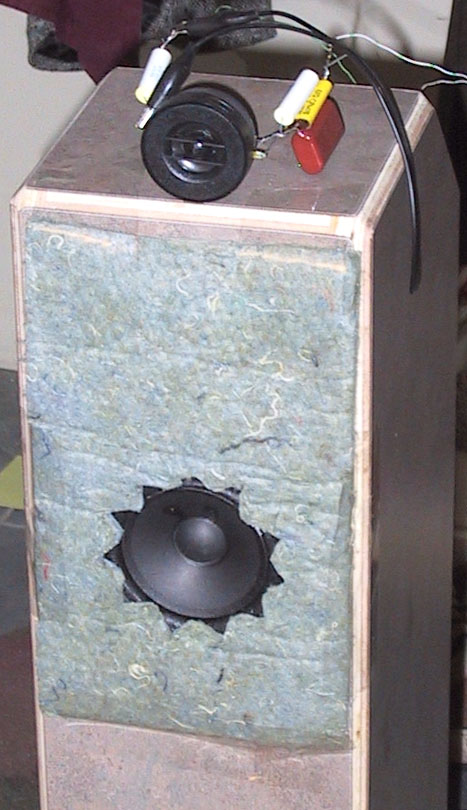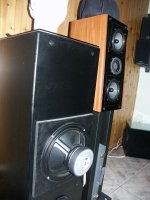these are my 2 subs finally finished. I have 2 Isobarik boxes (75 liters) using 2 Peerless 831727 each, tuned with a 4 inch port 38 inches long, tuned to 22 Hz. These are very musical subs, not boomy. the box is 1 inch MDF all around . Total weight is 75 pounds each. I also built an small 1 cu foot sealed box with an Peerless 10 inch 269 and its passive radiator. This one doesn't get as down as the Iso (-3 at 30Hz) but it makes up in total output. Really good for H/T, very quiet motor
Attachments
Push-pull, two woofer sharing the same enclosure with one driver's magnet firing out of the sub so both cones move together.
Isobarik is used as a piston to reduce the size of the sub.
Isobarik is used as a piston to reduce the size of the sub.
I first built them with a single hp and I got very good response.
Adding the second woofer in Iso config, changed everything. The bass just tightened a whole lot. Boomy bass just dissapeared. Adding the seconf woofer did not really improved on dynamics. I still could bottom the speakers on h/t,(That's the reason I built the small 269 Peerless). What it did is change the whole speaker response, I guess it is true that all the distorsion is cancelled in the process. If you can, add that in your design, you wont be sorry.
Happy listening
Adding the second woofer in Iso config, changed everything. The bass just tightened a whole lot. Boomy bass just dissapeared. Adding the seconf woofer did not really improved on dynamics. I still could bottom the speakers on h/t,(That's the reason I built the small 269 Peerless). What it did is change the whole speaker response, I guess it is true that all the distorsion is cancelled in the process. If you can, add that in your design, you wont be sorry.
Happy listening
I do like the speakers in the background! Is that a focal tweeter? If so - how much and from where?! Are they DIY?
More info thanx! 😉
Gaz
More info thanx! 😉
Gaz
Yes, they are the JM Lab Electra 905, the model just before they changed to the 906, not DIY thou. I have added a ring around the tweeter, made of mousse to improve their imaging.
Cheers
Cheers
Hello ! My first reply on this great DIY forum... 😉
Here is what it looks like :
http://www.homecinema-fr.com/forum/download.php?id=1141
😉
Vincent
I made it too around Focal TC 120 TD5, that's very beneficial : I removed a little peak in the frequency response at about 3 kHz and the imaging has been improved too. 😉I have added a ring around the tweeter, made of mousse to improve their imaging.
Here is what it looks like :
http://www.homecinema-fr.com/forum/download.php?id=1141
😉
Vincent
I am at the moment making a similar sub using 2 of the 831875 12" classic series drivers in a 60 ltr box .
could you tell me how far apart you have the drivers .
did you just guess how much you needed or is there a way to do this
Also what is the idea behind the material around the tweeter .
Are some materials better than others . Will this work on any tweeter ? thanks
could you tell me how far apart you have the drivers .
did you just guess how much you needed or is there a way to do this
Also what is the idea behind the material around the tweeter .
Are some materials better than others . Will this work on any tweeter ? thanks
For the material around the tweeter :
I use a material which is called "thibaude de laine" in France. 😉 This is particularly effective in absorbing the mid/high (so what interest us for the tweak).
This who hifidan is using is effective too. 😉
I'll try to explain why making this tweak...
When placing the tweeter in the medium of the baffle, some "bad" waves appear on the baffle around the tweeter, which are deterioring the imaging and can cause a little peak on the frequency response.
Another tweak really effective is not to place the tweeter on the medium of the baffle, but on a side of the baffle (prefer the right side for the left loudspeaker and conversely).
Some manufacturers are using those tweaks.
😉
Vincent
I use a material which is called "thibaude de laine" in France. 😉 This is particularly effective in absorbing the mid/high (so what interest us for the tweak).
This who hifidan is using is effective too. 😉
I'll try to explain why making this tweak...
When placing the tweeter in the medium of the baffle, some "bad" waves appear on the baffle around the tweeter, which are deterioring the imaging and can cause a little peak on the frequency response.
Another tweak really effective is not to place the tweeter on the medium of the baffle, but on a side of the baffle (prefer the right side for the left loudspeaker and conversely).
Some manufacturers are using those tweaks.
😉
Vincent
busterno1 said:Also what is the idea behind the material around the tweeter .
Are some materials better than others . Will this work on any tweeter ?
The idea is to absorb the wave that travels along the baffle before it has a chance to defract and rereadiate.
The material pictured by Vince35 is a loose speaker damping material which may or may not be largely made out of wool.
The JMLabs above have a round ring which is probably the worst possible shape, the square cutout is better, i like something even more complex -- i use stars with a prime number of points and cut such that the leading edge of the cut is at an angle. I typically use fairly dense (& thick) woolfelt.

dave
Isobarik subs
Hi BusterNo1, the idea is to space the drivers far enough so that mechanically, they wont touch each other at max X.
As far is the ring around the tweeter, I used an old foam mouse carpet that was laying around. Cheers
Hi BusterNo1, the idea is to space the drivers far enough so that mechanically, they wont touch each other at max X.
As far is the ring around the tweeter, I used an old foam mouse carpet that was laying around. Cheers
Nre LM Lab Micro Utopia
My dealer had the last pair of Micro Utopia(Not berylium) at a price that I could not refuse.
i will be back with some comments after they are burned in.
Cheers
My dealer had the last pair of Micro Utopia(Not berylium) at a price that I could not refuse.
i will be back with some comments after they are burned in.
Cheers
With this recent trend for actually DIYing drivers, I'm going to have a go at a berylium tweeter...All I'd need is a sharp penknife and some double sided sticky tape and some cardboard. 😉
I wish! But in their promotional material, the construction doesn't look difficult after you actually manage to cut into the stuff. I wonder how it sounds compared to the non "be" version.
Gaz
I wish! But in their promotional material, the construction doesn't look difficult after you actually manage to cut into the stuff. I wonder how it sounds compared to the non "be" version.
Gaz
Rarkov said:But in their promotional material, the construction doesn't look difficult after you actually manage to cut into the stuff. I wonder how it sounds compared to the non "be" version.
Berylium is a VERY poisonous material...
dave
Aye, that as well...
Don't know what all the fuss is about really. They sent people into mines, or chemical factories or asbestos ghost ships...etc
I'm sure the ppl who make be tweeters are just as safe and wrapped up.
Gaz
Don't know what all the fuss is about really. They sent people into mines, or chemical factories or asbestos ghost ships...etc
I'm sure the ppl who make be tweeters are just as safe and wrapped up.

Gaz
- Status
- Not open for further replies.
- Home
- Loudspeakers
- Subwoofers
- Peerless Isobarik
